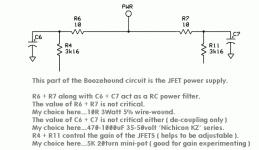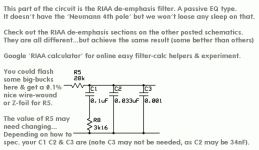I am building my own point to point (no circuit board) version of the Boozehound labs jfet phono pre. I like all the Russian caps that were selected by BHL for the pre having a great cost to performance ratio. I am using all the stock caps on my build.
My question going out in to the diy community is about resistor selection for best audio quality and lowest noise for the Boozehound jfet phono pre. This is a low voltage solid state design and I would like to choose appropriate resistors for the circuit
Here is the link to the BHL jfet phono web page schematic:
Boozhound Laboratories: Phono Preamp Assembly Manual
Boozehound description of the pre has a comment that the resistors were good quality but not as tweaked out as the capacitor selection was.
Soooo....I have tried a few resistors in my day and I planned to maybe use some Caddock TF020 on the 100ohms in the circuit path and maybe some Mills wirewounds on the 10 ohm and 3.16K on the power supply section.
Any suggestions for the rest of the circuit, including alternate suggestions to my choices above?
I would like to use different brands and types of resistors to stop cumulative buildup of sound qualities, in other words to make the sound interesting and not have the same sheen on every recording.
Also I would like to keep the cost to reasonable under $10 per resistor ($5 and under would even be better), yes I know Vishay nudes are great but they fall apart if you look at them wrong and it gets pricey when you have to keep replacing them. (yes, folks if you have not tried the Vishay nudes BE EXTREMELY CAREFUL when soldering and handling them they are extremely delicate as there is hardly any material holding them together!)
Thanks for any help.
My question going out in to the diy community is about resistor selection for best audio quality and lowest noise for the Boozehound jfet phono pre. This is a low voltage solid state design and I would like to choose appropriate resistors for the circuit
Here is the link to the BHL jfet phono web page schematic:
Boozhound Laboratories: Phono Preamp Assembly Manual
Boozehound description of the pre has a comment that the resistors were good quality but not as tweaked out as the capacitor selection was.
Soooo....I have tried a few resistors in my day and I planned to maybe use some Caddock TF020 on the 100ohms in the circuit path and maybe some Mills wirewounds on the 10 ohm and 3.16K on the power supply section.
Any suggestions for the rest of the circuit, including alternate suggestions to my choices above?
I would like to use different brands and types of resistors to stop cumulative buildup of sound qualities, in other words to make the sound interesting and not have the same sheen on every recording.
Also I would like to keep the cost to reasonable under $10 per resistor ($5 and under would even be better), yes I know Vishay nudes are great but they fall apart if you look at them wrong and it gets pricey when you have to keep replacing them. (yes, folks if you have not tried the Vishay nudes BE EXTREMELY CAREFUL when soldering and handling them they are extremely delicate as there is hardly any material holding them together!)
Thanks for any help.
Don't dismiss the 'regular' Vishay bulk foil resistors in conventional packaging. They're still the best resistors on technical grounds and are (slightly) less expensive. Wirewound resistors with low temperature coefficients share attributes with bulk metal foil; the latter might really be thought of as miniaturized wirewounds.
I never liked the 'nude' bulk metal foils because they are much less mechanically robust.
Otherwise, consider metal film resistors with the lowest temperature coefficient you can find, 25 ppm or better. Vishay/Dale PTF series are one example, being 5 ppm or better. Any metal film resistor you can find with .1% tolerance will have a lower Tc. .01% is available on certain types such as the PTF, and should be the most stable of all, to be specified that tightly. Also, chose higher wattage parts if available, ie, 1/2 instead of 1/8 or 1/10 watts; I think in both examples the metal film is thicker and should have a better voltage coefficient.
Caddock resistors I'm far less familiar with except for voltage dividers, but they seem to have a good reputation.
I don't care for any kind of carbon resistor because they are inherently less stable, and even nonlinear. They will color the sound slightly, perhaps euphonically so. Some like the 'warmer' quality however, and a good carbon film could be selected to adjust the sound to your tastes.
I never liked the 'nude' bulk metal foils because they are much less mechanically robust.
Otherwise, consider metal film resistors with the lowest temperature coefficient you can find, 25 ppm or better. Vishay/Dale PTF series are one example, being 5 ppm or better. Any metal film resistor you can find with .1% tolerance will have a lower Tc. .01% is available on certain types such as the PTF, and should be the most stable of all, to be specified that tightly. Also, chose higher wattage parts if available, ie, 1/2 instead of 1/8 or 1/10 watts; I think in both examples the metal film is thicker and should have a better voltage coefficient.
Caddock resistors I'm far less familiar with except for voltage dividers, but they seem to have a good reputation.
I don't care for any kind of carbon resistor because they are inherently less stable, and even nonlinear. They will color the sound slightly, perhaps euphonically so. Some like the 'warmer' quality however, and a good carbon film could be selected to adjust the sound to your tastes.
Last edited:
Damon, thanks for the input, taking a closer look I realize Vishay does seem to make quite a few different series of resistors at wildly different price points.
What I am looking for is listening comments on specific resistors if you have made any tests between the different Vishay models.
There are so many different models from many different companies and I know from experience they all sound slightly different, I don't have the time to buy and try them all so I am hoping to narrow it down with other peoples experiences.
Here are some really cheap ,Vishay metal films RN and RL series at Mouser and they still have 5ppm, etc..
http://www.vishay.com/docs/31027/cmfmil.pdf
The more pricey possible higher audio quality Vishay's I have found so far that I might want to use are:
1. VSH-limited inventory at M. Percy but only $4 each
2. VTA-$9.95each at Parts Connexion
Also I am wondering if the larger values are necessary in some parts of the circuit? I am under the impression that the power supply resistors need the bigger values for lower noise but I am not sure if it is necessary say in the passive RIAA eq section?
What I am looking for is listening comments on specific resistors if you have made any tests between the different Vishay models.
There are so many different models from many different companies and I know from experience they all sound slightly different, I don't have the time to buy and try them all so I am hoping to narrow it down with other peoples experiences.
Here are some really cheap ,Vishay metal films RN and RL series at Mouser and they still have 5ppm, etc..
http://www.vishay.com/docs/31027/cmfmil.pdf
The more pricey possible higher audio quality Vishay's I have found so far that I might want to use are:
1. VSH-limited inventory at M. Percy but only $4 each
2. VTA-$9.95each at Parts Connexion
Also I am wondering if the larger values are necessary in some parts of the circuit? I am under the impression that the power supply resistors need the bigger values for lower noise but I am not sure if it is necessary say in the passive RIAA eq section?
3 Watt Wire-wounds !!!
Bog standard £0.40p + VAT each ( thereabouts ).
Can't easily get 'em at say 47K though.
Could consider 'thick-film' non-inductive planar, for cartridge load ( 47K ).
I think as you say 'L' Pacific' ie. Boozehound, doesn't have a 100R, on input; I don't think you realy need it; if you must...wire-wound 0.1% precision non-inductive.
Good to have the resistors above the JFETS as chunky wire-wounds as well...dead stable.
Save all that dough on fancy name strippy-things...
...and made a DECENT power-supply !...
...you'll need it.
You'll never fully realise the full qualitys of the hyper-minimal 'L' Pacific' without a top-notch PSU...and I do mean top-notch.
Do get a decent wire-wound for the high-value resistor ( about 27K, I think ) in series, before the Passive EQ section.
Matching per position & per channel helps on this design alot.
Don't worry if your wire-wounds are say 5% tolerance...get a bunch...they're cheap...and match them out per channel & per position...
...they'll never go off in this apllication ( no heat / current )...
...as noise-free as it gets...
...as quiet as a grave.
Let the caps you like do 'the sonic thang'...
...and mix and match a few around, on the interstage & output positions...tolerance not that critical here.
Measure the caps on the EQ section...& try and match them if you can ( as the resistors, here ); by adding an apropriate small value polystyrene or silver-mica across them to match the values.
( if you have a C meter that is ).
Another good thing to do is to go on-line to 'an RIAA calculator' page, & follow the instructions there; input your known resistor value etc....
...and easily calculate the spot-on cap & R values for the RIAA deemphasis...
...the Boozehound / 'L' Pacific's are only an aproximation here...
...match it yourself & per channel &...BINGO....super-wide detailed soundstage.
Good luck.
This tape will self destruct in 5 seconds...............................................
Si.
Bog standard £0.40p + VAT each ( thereabouts ).
Can't easily get 'em at say 47K though.
Could consider 'thick-film' non-inductive planar, for cartridge load ( 47K ).
I think as you say 'L' Pacific' ie. Boozehound, doesn't have a 100R, on input; I don't think you realy need it; if you must...wire-wound 0.1% precision non-inductive.
Good to have the resistors above the JFETS as chunky wire-wounds as well...dead stable.
Save all that dough on fancy name strippy-things...
...and made a DECENT power-supply !...
...you'll need it.
You'll never fully realise the full qualitys of the hyper-minimal 'L' Pacific' without a top-notch PSU...and I do mean top-notch.
Do get a decent wire-wound for the high-value resistor ( about 27K, I think ) in series, before the Passive EQ section.
Matching per position & per channel helps on this design alot.
Don't worry if your wire-wounds are say 5% tolerance...get a bunch...they're cheap...and match them out per channel & per position...
...they'll never go off in this apllication ( no heat / current )...
...as noise-free as it gets...
...as quiet as a grave.
Let the caps you like do 'the sonic thang'...
...and mix and match a few around, on the interstage & output positions...tolerance not that critical here.
Measure the caps on the EQ section...& try and match them if you can ( as the resistors, here ); by adding an apropriate small value polystyrene or silver-mica across them to match the values.
( if you have a C meter that is ).
Another good thing to do is to go on-line to 'an RIAA calculator' page, & follow the instructions there; input your known resistor value etc....
...and easily calculate the spot-on cap & R values for the RIAA deemphasis...
...the Boozehound / 'L' Pacific's are only an aproximation here...
...match it yourself & per channel &...BINGO....super-wide detailed soundstage.
Good luck.
This tape will self destruct in 5 seconds...............................................
Si.
Hi again Audio Mind !
Also...
...check out these 2 threads here on diyAudio ( sorry no links, use search )
Member Mad_K :- " Mad_K's 'L' Pacific' "
A good few pages ( but not TOO long ), a few people build it, tweek it, get the most performance out of it ( pre-Boozehound era. ).
Exellent thread...you will know EVERY worthwhile aspect of this hyper-minimalist design after reading this one...
...WELL worth-it !!!
Also...
Member Thorsten Loesch's thread :- " 'L' Pacific Optime ".
Mods this time; on the original.
Bumps up the VOLTS and the transistor count of the original.
But worth reading to see where you can take it if you wish.
Another good read from the pre Boozehound era.
One issuse that is common...
...I think Boozehound may have tweeked the gain a bit to stop this .....but...
Sometimes with high-output MM carts... the gain from the first stage is too high...
...and can overload the 2nd stage JFET....which likes not much more than about 300mV.
I think Boozehound have reduced the gain a tad to avoid this.
The original & the Thorsten Loesch version by the way, use the GR suffix version of the 2SK170 JFET; the Boozehound uses the BL suffix of this JFET ( I think / assume ). GR suffix not as easy to get hold of, but possible though.
GR = about 4-5 Idss
BL = about 7-9 Idss
V = higher than 10 probably
Fantastic little pre-amp.
Who needs more than 2 transistors ?
Well I'd have 4 myself ....but 'L' Pacific' does just Hunky Dory with TWO !
Cheers
Si.
Also...
...check out these 2 threads here on diyAudio ( sorry no links, use search )
Member Mad_K :- " Mad_K's 'L' Pacific' "
A good few pages ( but not TOO long ), a few people build it, tweek it, get the most performance out of it ( pre-Boozehound era. ).
Exellent thread...you will know EVERY worthwhile aspect of this hyper-minimalist design after reading this one...
...WELL worth-it !!!
Also...
Member Thorsten Loesch's thread :- " 'L' Pacific Optime ".
Mods this time; on the original.
Bumps up the VOLTS and the transistor count of the original.
But worth reading to see where you can take it if you wish.
Another good read from the pre Boozehound era.
One issuse that is common...
...I think Boozehound may have tweeked the gain a bit to stop this .....but...
Sometimes with high-output MM carts... the gain from the first stage is too high...
...and can overload the 2nd stage JFET....which likes not much more than about 300mV.
I think Boozehound have reduced the gain a tad to avoid this.
The original & the Thorsten Loesch version by the way, use the GR suffix version of the 2SK170 JFET; the Boozehound uses the BL suffix of this JFET ( I think / assume ). GR suffix not as easy to get hold of, but possible though.
GR = about 4-5 Idss
BL = about 7-9 Idss
V = higher than 10 probably
Fantastic little pre-amp.
Who needs more than 2 transistors ?
Well I'd have 4 myself ....but 'L' Pacific' does just Hunky Dory with TWO !
Cheers
Si.
Whew..a simple pre done right can be quite complicated! Have to search a little harder for the thread recommened. Si you mentioned the need for a real good psu. Was thinking of using a discrete regulation, a buddy told me to look in to the Salas shunt type. People who have heard both 3 pin chip and discrete voltage unanimously say the discrete is superior in sound quality and noise. Back to resistors I was wondering about tantalums in a low voltage low current solid state design such as this. Tube guys seem to like them but i wonder if it would be better to stick to metal films and wire wounds?
Hi Audio Mind
Having been an LM317 reg. user for some time...
...mostly in high-level line stuff...
...I am just about to start building 4 of Salas's LV shunt-regs; and some HT valve ones as well.
I am sure it will be a very good move; especialy for low-level stuff, like phono's & mic-pre's.
No fancy resistors needed either.
Might use some wire-wounds though.
Get a BIG heatsink as well !!!
The shunt-reg drops quite a few Volts...
...so a 24 Volt transformer is probably what you need.
Check out the 'Simplistic LV shunt' thread in the power supplies forum.
Get an R-Core type 50VA transformer from eBay etc.
They are much better at suppressing RF interference from the mains power...well worth it for an ultimate-build in my opinion.
I am making several items at present.
There are no 'audiophille' resistors in any of them.
Just quality components...chosen on the basis of purpose.
Seeing as I can buy 1/2 a dozen LP's for the same price as 1 tantalum resistor, I know where I'm at.
You may have just won the LOTTO though.
Would anyone recommend tantalum capacitors...
...No...not here anyway.
Go figure.
When you've built the preamp...
...you will no doubt have lot's of fun tweeking it 'sonicaly'.
The resistors IMO will have about a 1% overall impact on the signature of the preamp.
The capacitors will have the rest.
This is also totaly down to personal opinion...
...not about money spent or brand names, just what sounds good to you.
The Ruskie PIO's are very much to a lot of peoples tastes...
...listen to see if they are to yours.
Also...
...the electrolytic capacitors in the PSU & on the P2P wiring, will have a sonic affect on the preamp.
I have been a stalwart user of Panasonic FM & FC series over the years; also Elna 'Starget'...
...however there are better out there according to word of mouth.
My new builds will have 'Nichicon KZ' type, simply because they appear to be the state of the art at present.
They are available cheaply on eBay ( alot cheaper than tantalum resistors ) and you don't need but a few; and you MIGHT hear the benifit's.
Do search out Mad_K's thread as well and read it all.
Search - Mad_K - threads started by member; you'll get there...
...much more interesting stuff there, than speculating about fancy components.
Cheers
Si.
Having been an LM317 reg. user for some time...
...mostly in high-level line stuff...
...I am just about to start building 4 of Salas's LV shunt-regs; and some HT valve ones as well.
I am sure it will be a very good move; especialy for low-level stuff, like phono's & mic-pre's.
No fancy resistors needed either.
Might use some wire-wounds though.
Get a BIG heatsink as well !!!
The shunt-reg drops quite a few Volts...
...so a 24 Volt transformer is probably what you need.
Check out the 'Simplistic LV shunt' thread in the power supplies forum.
Get an R-Core type 50VA transformer from eBay etc.
They are much better at suppressing RF interference from the mains power...well worth it for an ultimate-build in my opinion.
I am making several items at present.
There are no 'audiophille' resistors in any of them.
Just quality components...chosen on the basis of purpose.
Seeing as I can buy 1/2 a dozen LP's for the same price as 1 tantalum resistor, I know where I'm at.
You may have just won the LOTTO though.
Would anyone recommend tantalum capacitors...
...No...not here anyway.
Go figure.
When you've built the preamp...
...you will no doubt have lot's of fun tweeking it 'sonicaly'.
The resistors IMO will have about a 1% overall impact on the signature of the preamp.
The capacitors will have the rest.
This is also totaly down to personal opinion...
...not about money spent or brand names, just what sounds good to you.
The Ruskie PIO's are very much to a lot of peoples tastes...
...listen to see if they are to yours.
Also...
...the electrolytic capacitors in the PSU & on the P2P wiring, will have a sonic affect on the preamp.
I have been a stalwart user of Panasonic FM & FC series over the years; also Elna 'Starget'...
...however there are better out there according to word of mouth.
My new builds will have 'Nichicon KZ' type, simply because they appear to be the state of the art at present.
They are available cheaply on eBay ( alot cheaper than tantalum resistors ) and you don't need but a few; and you MIGHT hear the benifit's.
Do search out Mad_K's thread as well and read it all.
Search - Mad_K - threads started by member; you'll get there...
...much more interesting stuff there, than speculating about fancy components.
Cheers
Si.
Si, thanks for all your input. I agree the capacitors probably make more of a difference in sound than the resistors in most parts of the circuit but there are 3 resistors directly in the circuit path and I know from experience they do make much more than 1% difference in sound because your whole signal is running through them. These are the only places I was going to spring for a $5-$10 resistor.
Yes Tant caps are not "audiophile approved" by any means but tant resistors are a completely different story and considered by some the best sounding resistors out there. The only thing is I usually see only the tube guys musing about the tant resistors in their high voltage circuits as most tant resistors have high voltage ratings. I will make more effort to find Mad_K thread.
I was going to use an EI tranny on each channel cause I have a few laying around, I do not like torroids on pre stuff as you say, they let in a little extra line harsh that is difficult to filter and adds complexity to ps. Plus I opened up my buddies $2500 Ayre P-5XE phono pre and there was an EI tranny sitting right there powering the whole thing.The
Ayre is a really quiet phono stage.
A friend told me the he had an r core and it did not have nearly as much bass as the equivalent C core. Any experience R versus C on your end?
Yes Tant caps are not "audiophile approved" by any means but tant resistors are a completely different story and considered by some the best sounding resistors out there. The only thing is I usually see only the tube guys musing about the tant resistors in their high voltage circuits as most tant resistors have high voltage ratings. I will make more effort to find Mad_K thread.
I was going to use an EI tranny on each channel cause I have a few laying around, I do not like torroids on pre stuff as you say, they let in a little extra line harsh that is difficult to filter and adds complexity to ps. Plus I opened up my buddies $2500 Ayre P-5XE phono pre and there was an EI tranny sitting right there powering the whole thing.The
Ayre is a really quiet phono stage.
A friend told me the he had an r core and it did not have nearly as much bass as the equivalent C core. Any experience R versus C on your end?
Hi A M
Yes, EI trafos also good at dumping RF hash.
Disadvantage...very wide magnetic field.
Oh well, I guess you're not going to mount the 1st stage JFET on top if it !!!
Yep...I would expect a quiet phono for $25000
R versus C...dunno...
If the trafo is influencing the amount of bass your mates getting...
...I would suspect either a SERIOUSLY under VA rated transformer...
...or a very poorly constructed power supply.
Never had any trafo under-power or frequency response issues myself...
...To me its just a FREE mains RF hash filter, that happens to supply Volts as well.
Cheers
Si.
PS will post some schematics...
...most people who make this basic design only have 1 series resistor...
...Boozehound have thrown in an extra 2 that you could possibly do without.
Some schematics coming up.
Yes, EI trafos also good at dumping RF hash.
Disadvantage...very wide magnetic field.
Oh well, I guess you're not going to mount the 1st stage JFET on top if it !!!
Yep...I would expect a quiet phono for $25000
R versus C...dunno...
If the trafo is influencing the amount of bass your mates getting...
...I would suspect either a SERIOUSLY under VA rated transformer...
...or a very poorly constructed power supply.
Never had any trafo under-power or frequency response issues myself...
...To me its just a FREE mains RF hash filter, that happens to supply Volts as well.
Cheers
Si.
PS will post some schematics...
...most people who make this basic design only have 1 series resistor...
...Boozehound have thrown in an extra 2 that you could possibly do without.
Some schematics coming up.
How Many Schematics Does It Take To Change A Light Bulb ?
All the same...but different...if you get my drift...man...

Si.
All the same...but different...if you get my drift...man...
Si.
Attachments
-
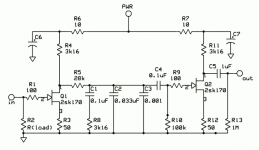 Boozhoundlab's - L' Pacific.gif23.7 KB · Views: 1,156
Boozhoundlab's - L' Pacific.gif23.7 KB · Views: 1,156 -
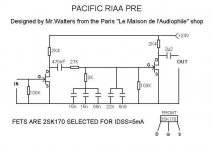 Mr Walter's 'L' Pacific' - Original Schematic.jpg39.5 KB · Views: 1,133
Mr Walter's 'L' Pacific' - Original Schematic.jpg39.5 KB · Views: 1,133 -
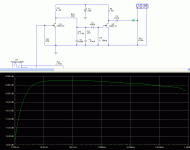 Mr Walter's 'L' Pacific' - Mad K's Version.gif15.1 KB · Views: 1,124
Mr Walter's 'L' Pacific' - Mad K's Version.gif15.1 KB · Views: 1,124 -
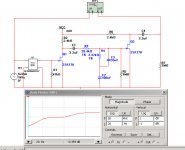 Maison N1 Topology.jpg65 KB · Views: 1,118
Maison N1 Topology.jpg65 KB · Views: 1,118 -
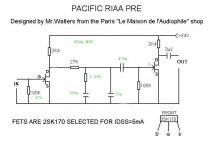 tschrama - L' Pacific RIAA Mod.jpg49 KB · Views: 1,114
tschrama - L' Pacific RIAA Mod.jpg49 KB · Views: 1,114 -
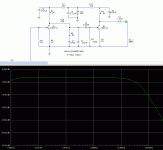 Mr Walter's 'L' Pacific' - Salas's Version.gif14.1 KB · Views: 334
Mr Walter's 'L' Pacific' - Salas's Version.gif14.1 KB · Views: 334 -
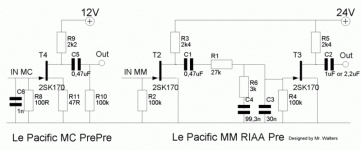 MC input 'L' Pacific'.gif31.2 KB · Views: 339
MC input 'L' Pacific'.gif31.2 KB · Views: 339 -
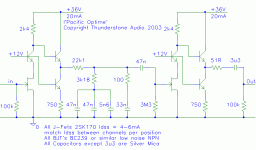 Thorsten's 'L' Pacific' BJT Stack 36 Volt.gif10.6 KB · Views: 347
Thorsten's 'L' Pacific' BJT Stack 36 Volt.gif10.6 KB · Views: 347 -
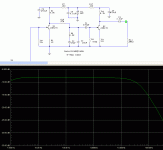 Resistors To Ground 'L' Pacific'.gif14.1 KB · Views: 350
Resistors To Ground 'L' Pacific'.gif14.1 KB · Views: 350 -
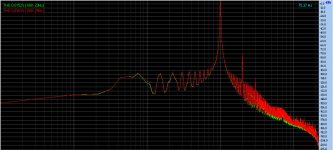 Mr Walter's 'L' Pacific' - Distortion.jpg121.1 KB · Views: 285
Mr Walter's 'L' Pacific' - Distortion.jpg121.1 KB · Views: 285
Boozehound Break-Down Part 1 - JFET psu & gain control...
Hi again A M
Just another thought...
...This circuit is one that pays dividends...through experimentation...so...
Buying in costly & fancy parts from the get-go...might well back-fire...
...and you end up finding they need value changes to optimise.
The gain resistors, for example, can be replaced with a fixed value...later...
...But in the mean while, a 5K 20 turn mini-pot would be a smart move !
Measure & set it to the schematic value to begin with...
...can optimise later...depending on cartridge output & JFET current draw.
A good thing to do first off as well...is measure the current draw of your JFETS to see if they are any good...ie well matched...if not ...you might want to get some more & test them as well.
...you might want to get some more & test them as well.
About 99% more important than a $1M resistor !



Si.
Hi again A M
Just another thought...
...This circuit is one that pays dividends...through experimentation...so...
Buying in costly & fancy parts from the get-go...might well back-fire...
...and you end up finding they need value changes to optimise.
The gain resistors, for example, can be replaced with a fixed value...later...
...But in the mean while, a 5K 20 turn mini-pot would be a smart move !
Measure & set it to the schematic value to begin with...
...can optimise later...depending on cartridge output & JFET current draw.
A good thing to do first off as well...is measure the current draw of your JFETS to see if they are any good...ie well matched...if not
About 99% more important than a $1M resistor !



Si.
Attachments
Si, thanks again for your help, this is starting to get fun.
The Ayre is $2500 not $25,000 but it is still very quiet, uses jfets and is going to be my reference pre to compare to the home made jfet pre's. I keep any transformer away from gain stages, orient them properly and shield them.
A little trick I found is to hook up a microphone to a simple mixer with a mic pre and listen on some headphones, then move the mic in the air around the transformer (while transformer has power running through it but no need to touch transformer, be careful) The mic allows you to hear where the worst transformer radiation noise is coming from. This can help you build a really good shield.
There are a lot of R core tranny's coming from China of questionable quality, this may have been the case. i will ask my friend next time I talk to him.
Also thank so much for posting all the schematics in one place to see how many variations there are on these things. I love the second one down all the way on the left (Pacific with RiAA mod). It is so elegant, I already have all the resistors to get it working and it gives me the peaceful feeling like looking at a really nice vintage tube schematic and knowing I can solder it up point to point in a very short amount of time.
The only problem I see is that I bought a bunch of 2sk170 BL jfets instead of the GR, that may give me some issues with the gain as you mentioned above. I don't know enough about circuit design to address this. Guess I need to read up on the threads to find every detail as you mentioned.
I can drop a few bucks on the 27k resistor because it is the only one in the signal path!
The Ayre is $2500 not $25,000 but it is still very quiet, uses jfets and is going to be my reference pre to compare to the home made jfet pre's. I keep any transformer away from gain stages, orient them properly and shield them.
A little trick I found is to hook up a microphone to a simple mixer with a mic pre and listen on some headphones, then move the mic in the air around the transformer (while transformer has power running through it but no need to touch transformer, be careful) The mic allows you to hear where the worst transformer radiation noise is coming from. This can help you build a really good shield.
There are a lot of R core tranny's coming from China of questionable quality, this may have been the case. i will ask my friend next time I talk to him.
Also thank so much for posting all the schematics in one place to see how many variations there are on these things. I love the second one down all the way on the left (Pacific with RiAA mod). It is so elegant, I already have all the resistors to get it working and it gives me the peaceful feeling like looking at a really nice vintage tube schematic and knowing I can solder it up point to point in a very short amount of time.
The only problem I see is that I bought a bunch of 2sk170 BL jfets instead of the GR, that may give me some issues with the gain as you mentioned above. I don't know enough about circuit design to address this. Guess I need to read up on the threads to find every detail as you mentioned.
I can drop a few bucks on the 27k resistor because it is the only one in the signal path!
Yes I know it's only a cheap one at $2500...
...I just added the extra ZERO to wag you !
( no typo ! )
Could have added 000000000 !!!!!!!!!!!
Anyhow...
....you could get your Boozehound to sound better !!!
Si.
EQ section info coming up next...
...stay tuned ( no pun intended ! )
...I just added the extra ZERO to wag you !
( no typo ! )
Could have added 000000000 !!!!!!!!!!!
Anyhow...
....you could get your Boozehound to sound better !!!
Si.
EQ section info coming up next...
...stay tuned ( no pun intended ! )
The BL ( blue ) grade JFET's I'm sure will be just fine...
...measuring them is easy & will tell you if they are OK.
Have you got a meter that measures 'capacitors' ?
Don't spend on the 27K ( no not $27000 ) resistor...until you have checked out the online RIAA calculators...& measured your capacitor values...you may wish to change the value.
Have you got the PIO caps or any others already ?
What have you got ?
Si.
...measuring them is easy & will tell you if they are OK.
Have you got a meter that measures 'capacitors' ?
Don't spend on the 27K ( no not $27000 ) resistor...until you have checked out the online RIAA calculators...& measured your capacitor values...you may wish to change the value.
Have you got the PIO caps or any others already ?
What have you got ?
Si.
Last edited:
My $25 000 000 phono-pre with 0.01% accurate RIAA equaliser ( yeah...right ! )
Here's the RIAA equaliser section.
A million-dollar series resistor...
+
Capacitors ( need to measure them )
Could be...
PIO
Teflon
Polypropylene
Values can be 'bumped-up' to the desired value by soldering small value...
Polystyrene ( NOT 'syroflex' TM ( TRASH ))
or
Silver Mica...
...across the main big capacitor.
Tip Here...
...measure the big ones first ( optimise with online RIAA calculator )...
...then order your Polystyrene or Silver Mica's in whatever smal pF or small nF values are needed to make up the correct value.

Si.
Here's the RIAA equaliser section.
A million-dollar series resistor...
+
Capacitors ( need to measure them )
Could be...
PIO

Teflon

Polypropylene

Values can be 'bumped-up' to the desired value by soldering small value...
Polystyrene ( NOT 'syroflex' TM ( TRASH ))

or
Silver Mica...
...across the main big capacitor.
Tip Here...
...measure the big ones first ( optimise with online RIAA calculator )...
...then order your Polystyrene or Silver Mica's in whatever smal pF or small nF values are needed to make up the correct value.
Si.
Attachments
Yes i have a cap meter and all the caps I received are very lose to spot on their stamped value, nice!
No I won't buy that expensive $27,000 dollar resistor yet. I am going to build whatever pre I decide on first with the cheap Radio shack resistors on hand until I finalize.
I am not so sure what I am going to build at the moment. I started out planning to build the Boozehound and bought all the jfet 2sk170 BL versions and the Russian PIO caps .1uf, .033, .001 and 1uf. I also have large selection of larger pio and other sized output and coupling caps laying around.
Although after seeing the Pacific "RIAA MOD" schematic second down on left on your list I think I am going to build that or a slight variation as it has 6 resistors as opposed to 12 on the BHL and I have plenty of .1uf and .47uf's laying around as well as the .033uf needed.
(Actually I bought enough parts to build two Boozehounds) just in case I needed a second one to pretend I am a DJ for a party here and there, so I a may just build a Boozehound anyway for kicks to compare with Pacific.
I also just read an quite lengthy interesting "Words of Wisdom" paper by John Curl talking about the many aspects of solid state design and he recommended not using a resistor before the gate on a jfet as it just adds noise. With my limited knowledge of circuit design I am taking very carefully John C advice and his legendary experience. I guess am going to be learning about circuit design as I build these and listen
http://www.q-audio.com/johncurl.pdf
No I won't buy that expensive $27,000 dollar resistor yet. I am going to build whatever pre I decide on first with the cheap Radio shack resistors on hand until I finalize.
I am not so sure what I am going to build at the moment. I started out planning to build the Boozehound and bought all the jfet 2sk170 BL versions and the Russian PIO caps .1uf, .033, .001 and 1uf. I also have large selection of larger pio and other sized output and coupling caps laying around.
Although after seeing the Pacific "RIAA MOD" schematic second down on left on your list I think I am going to build that or a slight variation as it has 6 resistors as opposed to 12 on the BHL and I have plenty of .1uf and .47uf's laying around as well as the .033uf needed.
(Actually I bought enough parts to build two Boozehounds) just in case I needed a second one to pretend I am a DJ for a party here and there, so I a may just build a Boozehound anyway for kicks to compare with Pacific.
I also just read an quite lengthy interesting "Words of Wisdom" paper by John Curl talking about the many aspects of solid state design and he recommended not using a resistor before the gate on a jfet as it just adds noise. With my limited knowledge of circuit design I am taking very carefully John C advice and his legendary experience. I guess am going to be learning about circuit design as I build these and listen
http://www.q-audio.com/johncurl.pdf
Last edited:
Yes...
...Mr Walter's original 'L' Pacific' is VERY minimalist.
Less resistors = Less NOISE...
...whether in practice, rather than theory, you will notice this is another matter...
...well worth bearing in MIND though.
As you see...
...the 100R series & the ones from JFET's to ground are not in the original...
...However...
...The ones from JFET's to ground could be a good move...
...I would loosen the purse-strings here and spend $0.50c on a pair of 100R 3watt 5% wire-wounds, for least theoretical circuit noise & super theoretical stability.
5% tolerance is fine...not a critical value really...Match per position per channel if possible though.
Just to say you did it, if nothing else !
Conrad Johnson...eat yer heart out !
Si.
Another EQ scheme coming up...
...this time a ZERO CAPACITOR option...Very Expensive...Very 'Audiophile'
...Mr Walter's original 'L' Pacific' is VERY minimalist.
Less resistors = Less NOISE...
...whether in practice, rather than theory, you will notice this is another matter...
...well worth bearing in MIND though.
As you see...
...the 100R series & the ones from JFET's to ground are not in the original...
...However...
...The ones from JFET's to ground could be a good move...
...I would loosen the purse-strings here and spend $0.50c on a pair of 100R 3watt 5% wire-wounds, for least theoretical circuit noise & super theoretical stability.
5% tolerance is fine...not a critical value really...Match per position per channel if possible though.
Just to say you did it, if nothing else !
Conrad Johnson...eat yer heart out !
Si.
Another EQ scheme coming up...
...this time a ZERO CAPACITOR option...Very Expensive...Very 'Audiophile'
My favorite 3watt wire-wounds BTW are...
...the green-round type 5% £0.50p each
( of course the tolerance is only in manufacturing, once measured, the value will not change EVER !!!...so go figure...6 of these for cost of 1 0.1% type...Z-Foil...get outta here ! )
People don't seem to like the 'square white type' much...never used 'em myself so can't comment.
or
...the black ( Vishay, I think ) 0.1% for more critical apps. £3.00p each
Si.
...the green-round type 5% £0.50p each
( of course the tolerance is only in manufacturing, once measured, the value will not change EVER !!!...so go figure...6 of these for cost of 1 0.1% type...Z-Foil...get outta here ! )
People don't seem to like the 'square white type' much...never used 'em myself so can't comment.
or
...the black ( Vishay, I think ) 0.1% for more critical apps. £3.00p each
Si.
I believe the majority is correct, the square white sand resistors are harsh sounding low fi to me, I would avoid those at all costs for critical designs. Wire wound always in place of white or beige square sand resistors is the way to go if possible.
I don't mind adding the resistor to ground off the jfet if needed.
You mentioned a zero capacitor design, does it use a +- supply? I would like to see that schematic.
Next is the power supply design to think about, I am wondering if a really stiff supply with chokes might sound better than a discrete regulator?
I don't mind adding the resistor to ground off the jfet if needed.
You mentioned a zero capacitor design, does it use a +- supply? I would like to see that schematic.
Next is the power supply design to think about, I am wondering if a really stiff supply with chokes might sound better than a discrete regulator?
- Status
- This old topic is closed. If you want to reopen this topic, contact a moderator using the "Report Post" button.
- Home
- Source & Line
- Analogue Source
- Resistors suggestions for Boozehound Jfet phono pre, etc.?
